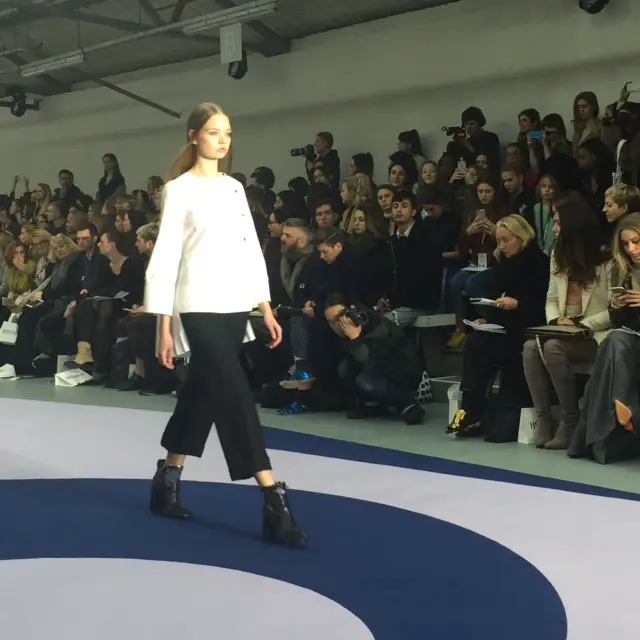
So, once again, the thorny issue of size and fashion is on the agenda right on time for London Fashion Week. This one comes round time and time again, and yet fundamental changes to unattainably tiny model sizes have yet to be universally addressed.
I’ve been back-stage many, many times, so I’ve seen it all; I’ve seen models being tugged into clothes that barely allow them to move, never mind breathe and I’ve also seen models so whippet thin that it looks painful. Dark circled, pale faces on elongated children’s bodies chugging on coconut water or Evian (or actually, whatever water is part of the event sponsorship, as things are now). I’ve even done backstage manicures – so I’ve been at the nitty gritty end of things as well as the glamour of the FROW.
There are women of all ages who are naturally thin and I know that they really mind that ‘thin’ has suddenly become wrong. It’s not wrong if it’s a natural shape that you’re happy with and I quite understand that being tarred with an eating disorder brush when you have the metabolism of a rocket is very annoying. So, I think we have to remember that thin is wrong when it’s something forced upon you, or when it’s presented as an ideal. Everyone is different, there is no ‘ideal’. We’re very inclined to take a moralizing stance over extremes (because you’re certainly not ‘allowed’ to be overweight either) and forget that these extremes trickle into our consciousness when we’re not even looking, and suddenly, with no warning, it’s an ‘ideal’. Just like in the beauty industry where the homogenised beauty ‘standard’ is nothing like real-life – but we’re still persuaded that that’s what we should look like. It’s exposure over time that does the damage, not one shock pic of an ultra-thin fashion model during Fashion Week.
So, that’s where the fashion industry – and the beauty industry – can make a change. It’s about balance and what we see over the long term. Although, I refuse to hold the fashion or the model industry entirely to account – have you seen Instagram lately for the utterly unattainable? It’s also worth noting that at beauty presentations we are often shown looks on models and on the one occasion that I’ve felt strongly enough to make comment (to the brand) upon a particular model who was at the very, very extreme end of thin (to the point she looked unwell), it was at a beauty presentation, not a fashion event. Actually, my biggest bug-bear at fashion shows is the stupidly high, badly fitting shoes models are made to walk in – one awkward tumble and that’s their entire modelling season gone, and all because the designer couldn’t be bothered to fit them a pair of shoes.
Maybe it’s time to pass over some of the responsibility to the fashion buyers – the shows aren’t entirely filled with celebrities and influencers. There is real work going on while store buyers (Harvey Nichols, Harrods, Selfridges et al) pick out their forthcoming season’s best sellers. If they refused to buy collections shown on excruciatingly thin models, then the designers would have to listen. A designer who sells nothing isn’t a designer any more.
And then there’s us in the responsibility chain. The consumers. I’ve never not bought an item of clothing because I thought the model it was shown on looked too thin..but I could. I’ve also never not bought a beauty product because the model was too airbrushed. But I could make those choices. We all could. And yet, we don’t. So, it’s all very well to throw all of the responsibility over to the fashion industry, but consumer is king. We should act more and speculate less if we really want change.
The #NoSizeFitsAll campaign from the Women’s Equality Party is to raise awareness of body image and to raise discussions on why tiny sizes are so idolised within the fashion industry. They don’t mention the beauty industry, but they should. What they’re asking for is entirely reasonable: BMI checks (under 18.5 needs medical clearance), and a commitment to showing two sample sizes (minimum) at London Fashion Week, one of which should be a UK size twelve or over.
The bigger picture stuff about this impactful campaign is that it could start a new behaviour, and therefore, goals changing. When women, young or old, stop seeing being thin as a goal and instead start to see being an appropriate weight as the norm (again, everyone is different), then it will be an achievement. But, this only comes if what we see over an extended period of time changes, which is where the media, fashion and beauty industries are called to do the right thing. Oh, and Instagram or any social account that suggests a filtered image as an attainable image.
The #YoursTruly campaign that I am involved with for L’Oreal features women of all tones, all sizes and all ages and it’s had a hugely positive response – I mean, huge. People love it because it’s made of people like us. And we like people like us, not people who’ve been formed by someone else to look like something else.
Have your own say HERE at Change.org.


Leave a Reply